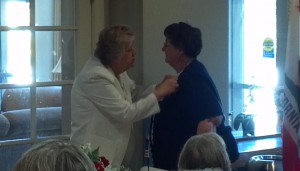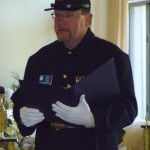On March 23, 2013, the Daughters of Union Veterans of the Civil War instituted their newest Tent (local chapter) in Sacramento. National President Carole Morton presided over the ceremony and installed the new Tent Officers. Newly-installed Tent President Joy Huskey, after receiving the official Charter for from President Morton, presented a certificate of appreciation to the Honor Guard. The Honor Guard was provided by Company B of the 8th California Regiment of the Sons of Veterans Reserve.
The DUVCW was organized on May 30, 1885 by Olive Howard, Harriet Knapp, Eva Merwin, Frank Merwin, and Bertha Martin – all young daughters of Union soldiers. The DUVCW is a heritage organizatoin, so all full members must have an ancestor who fought for the Union cause in the Civil War. In the most solemn part of the Tent Institution Ceremony, the names of the ancestors of the Tent members are read aloud. This list, known as the Roll of Honor, was read by SUVCW Brother Allen Davis.
The new Tent is named in honor of Margaret Rhodes Crocker, a key historic figure in California’s Gold Rush and Civil War eras. She was married to Edwin Crocker, an attorney and member of the California Supreme Court during the Civil War. Leland Stanford, who appointed Edwin to the Supreme Court when he was governor, invited Edwin to join in his railroad enterprise after the war, and the Crockers became one of the wealthiest families in California.
Margaret lived quietly until a series of tragedies, including the death of two daughters and her husband in the 1870s. After these hardships, she began charitable work, putting the family’s railroad fortune to work by establishing stipends for needy families and contributing heavily to schools and churches. Her profile by the Sacramento Bee newspaper credits her with “one thousand and one little deeds of charity which have lightened many a burden.”





